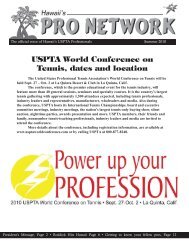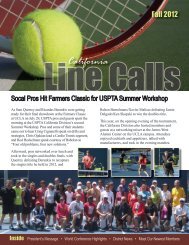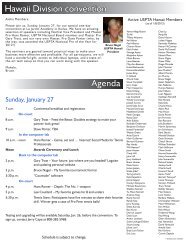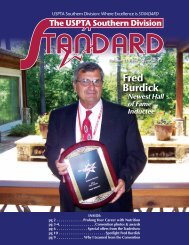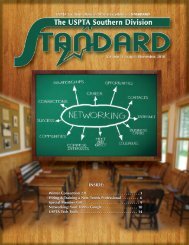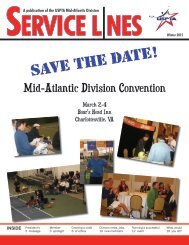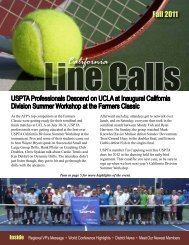Newsletter - USPTA divisions - United States Professional Tennis ...
Newsletter - USPTA divisions - United States Professional Tennis ...
Newsletter - USPTA divisions - United States Professional Tennis ...
Create successful ePaper yourself
Turn your PDF publications into a flip-book with our unique Google optimized e-Paper software.
By GRETCHEN REYNOLDS<br />
Columnist.<br />
When Dr. Douglas Brown,<br />
a radiologist in Provo, Utah,<br />
noticed an uptick recently<br />
in the number of barefoot<br />
runners he was seeing with<br />
heel and foot problems, he<br />
wondered if there might be<br />
a connection between their<br />
unshod training and their<br />
sore feet. But he couldn’t find<br />
any scientific studies that had<br />
examined the issue.<br />
So he approached Sarah<br />
Ridge, a professor of exercise<br />
science at Brigham Young<br />
University in Provo who studies<br />
impact injuries in sports, and<br />
suggested she undertake one.<br />
The resulting study,<br />
published last month in<br />
Medicine & Science in Sports<br />
& Exercise, will probably add<br />
fuel to the continuing debate<br />
about the benefits of running<br />
barefoot or wearing minimalist<br />
“barefoot” shoes. Does the<br />
barefoot style reduce a<br />
runner’s risk of pain and injury<br />
(as enthusiasts believe)? Or<br />
does barefoot running simply<br />
contribute to the development<br />
of a different set of injuries in<br />
some runners?<br />
To find out, Dr. Ridge began<br />
by recruiting 36 experienced<br />
runners, men and women,<br />
who, until then, had run<br />
between 15 and 30 miles a<br />
week while wearing normal<br />
running shoes. She sent them<br />
to Dr. Brown for baseline M.R.I.<br />
scans of their feet and lower<br />
legs to check for any injuries or<br />
problems.<br />
Those who believe in<br />
barefoot running often point<br />
out that humans ran and<br />
walked without shoes for<br />
millenniums before footwear<br />
was invented. They argue that<br />
being unshod is normal for<br />
humans and should reverse<br />
past injuries related to modern<br />
running shoes and prevent<br />
future ones.<br />
But anecdotal evidence,<br />
including from physicians<br />
who treat runners, indicates<br />
that some people who take<br />
up barefoot running develop<br />
entirely new aches and<br />
injuries.<br />
Dr. Ridge’s volunteers<br />
all started the study with<br />
normal feet and lower legs,<br />
according to their M.R.I. scans,<br />
which were read by multiple<br />
radiologists.<br />
Half of the group members<br />
were randomly assigned to<br />
continue running as they had:<br />
same mileage, same shoes.<br />
The other runners were given<br />
a pair of Vibram Five Fingers<br />
barefoot-style shoes and<br />
asked to begin incorporating<br />
some barefoot-like mileage<br />
into their runs, but gradually.<br />
They were told to wear the<br />
minimalist shoes for one mile<br />
during the first week of the<br />
study, two miles the second,<br />
three the third, and then as<br />
much as they liked, which is<br />
what the Vibram Web site<br />
recommended at the time of<br />
the 2011 study.<br />
After 10 weeks, both groups<br />
of runners received a follow-up<br />
M.R.I. There was no evidence<br />
of injuries to or changes in the<br />
tissues of the lower leg, like the<br />
Achilles’ tendon, in any of the<br />
runners. But more than half<br />
of the runners wearing the<br />
minimalist shoes now showed<br />
early signs of bone injuries in<br />
their feet.<br />
Specifically, most had<br />
developed bone marrow<br />
edema, an accumulation of<br />
fluid, similar to what happens<br />
during bruising, in their foot<br />
bones. The radiologists graded<br />
the edema on a scale of 0 to 4,<br />
with 0 representing no edema<br />
and 1 the slight bone damage<br />
caused by simply moving<br />
around on and loading the<br />
foot. This amount of edema<br />
is considered healthy, a sign<br />
that the bone is responding to<br />
training and growing stronger.<br />
Most of the runners in<br />
HEALTHY HABITS…<br />
Barefoot Running Can Cause Injuries, Too<br />
the control group, who<br />
were wearing their normal<br />
shoes, had edema levels of 1<br />
throughout their feet.<br />
But a majority of the runners<br />
in the minimalist-shoe group<br />
had developed at least a level<br />
2 edema, “which indicates<br />
early bone injury,” Dr. Ridge<br />
said, and three had signs of<br />
more-extensive level 3 bone<br />
edema, “which constitutes an<br />
actual injury.”<br />
Two even had full stress<br />
fractures or level 4 edema, one<br />
in her heel bone and one in<br />
his metatarsal, one of the long<br />
foot bones.<br />
Almost all of the runners<br />
in the minimalist shoe group<br />
were spontaneously running<br />
fewer miles at the end of the<br />
10 weeks than they had been<br />
at the start, “probably,” Dr.<br />
Ridge said, “because their feet<br />
hurt.”<br />
Why some of the barefootstyle<br />
runners developed<br />
serious foot problems and<br />
others did not is not yet clear,<br />
but Dr. Ridge is now analyzing<br />
additional data about the<br />
volunteers, which includes<br />
information about each<br />
runner’s mileage, running<br />
form, body weight and other<br />
variables.<br />
“What we hope to see is<br />
whether there are some<br />
runners who, because of their<br />
biomechanics or other factors”<br />
seem to be particularly<br />
predisposed to foot injuries<br />
during the transition to<br />
barefoot-style running and<br />
“perhaps shouldn’t” make<br />
the switch at all from normal<br />
running shoes, she said.<br />
She hopes to have findings<br />
ready to publish by this<br />
summer.<br />
The results don’t mean<br />
that everyone who chooses<br />
to switch to minimal or no<br />
footwear will court foot injury,<br />
Dr. Ridge said. “But I would<br />
tell anyone who wants to try”<br />
kicking off their normal shoes,<br />
“to be extremely cautious<br />
during the transition period.”<br />
In her study, substituting a<br />
mere mile per week of normal<br />
running at the start with one in<br />
minimal shoes “was probably<br />
too much,” she says. So go<br />
slow.<br />
Barefoot-style running may<br />
have been natural for our<br />
ancestors, Dr. Ridge points<br />
out, but it’s a new experience<br />
for most of our feet.<br />
www.nytimes.com<br />
15




